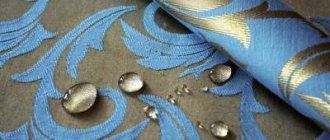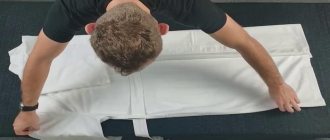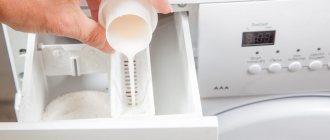The cleanliness of the white coat is an integral part of maintaining the image and professionalism of a medical professional.
Proper washing will keep things clean and protect the material from rapid wear. In the process of caring for such clothes, you will have to face the need to remove stains and bleach.
Read the article on how to wash a white medical gown at home in a washing machine and by hand.
Washing rules
It is worth clarifying that it is permissible to wash medical clothing at home that is not contaminated with biomaterials (for example, the blood of infected patients) that are potentially dangerous to a third party.
This form is disposed of or cleaned at professional processing sites. If the medical gown is “clean” and harmless, it can be washed on its own, subject to certain rules.
It is also important to take into account that things for doctors, nurses and orderlies are usually made from natural (calico, cotton) and from mixed materials (synthetic substances are introduced into the fibers of the former). These materials differ somewhat in their properties.
And if calico and cotton are known for their tendency to wrinkle, then synthetics do not have such a drawback. It is also important that a single-color medical gown is decorated with rich-colored trim.
Hand wash white robe
To prevent the decor from fading and damaging the clothes, this must be taken into account when washing:
- Clothes are washed as they become dirty or lose their freshness. Uniforms for a number of specializations require daily cleaning.
- White medical gown is washed separately from colored uniforms and household items.
- The process uses special-purpose disinfectants.
- Before washing, the product is soaked for some time in cool water with a special product. Hot water is excluded - it will only fix the stains, and then it will be more problematic to wash them off.
- It will help to properly clean the gown and other workwear by studying the information on the label (if there is one). It indicates recommendations regarding washing features.
- The main attention is the temperature of the water intended for the washing process. There is no temperature limit - it is also permissible to boil clothes. If the limit is set, it is not worth conducting the experiment to avoid damage to clothing.
ARTICLE FOR YOU
How to properly wash baby strollers in a washing machine and by hand
Wash by hand
This method of processing must be preceded by soaking the professional item for at least 30 minutes. with the detergent and disinfectant chosen for washing, for example fir oil.
The natural antiseptic is inexpensive and will destroy up to 98% of bacteria. Then the product will be washed better, and the problem of old stains will be solved, for which you can add a little stain remover to the soaking solution.
Plain bathrobes made from mixed fabrics are washed in water at 60°C after soaking. Cotton and decorated items should be washed in water at 30-40°C to avoid shedding. Cotton clothing will not shrink too much.
Products with snaps, large buttons, or zippers are best fastened and washed from the front and back. This will help you get rid of dirt and odors better.
A medical gown should not be subjected to strong friction in a soapy solution. With proper washing, the dirt will “go away”. The washed item must be rinsed in more than one portion of clean water, and the item can be wrung out. Soft cotton items can be starched to give them moderate stiffness.
Useful tips
In order to extend the service life of a medical gown and maintain its presentable appearance for a long time, several recommendations should be taken into account:
- Cotton items cannot be washed together with synthetics.
- When washing cotton, the ideal temperature is 60 degrees. In this case, add a little salt to the water.
- When using laundry detergents, it is recommended to first test them on a small piece of fabric.
This way you can extend the life of the medical gown and eliminate the need for frequent use of bleaching agents.
Washing in a washing machine
Professional clothing should also be washed in an automatic machine after disinfectant soaking. If there are several samples, they must be sorted and soaked in separate containers.
When the locking time has expired, a batch of items with similar properties is loaded into the drum. The washing cycle is set according to the information on the label.
For white coats made of cotton-blend fabric, select the “Cotton 60°C” mode with preparatory soaking and rinsing twice.
For colored bathrobes, a wash cycle lasting over 1 hour at 40°C and double rinsing is used.
Washing a robe in a washing machine
How to starch a cap
In order for the cap to acquire a good stand, you will need gelatin, PVA glue and starch (it is better to use potato starch).
If the cap is not new, if there is dirt, be sure to get rid of it. Only clean cloth is used for starching.
Take 2 tablespoons of starch per liter of water. Store bought will do, you can get it yourself.
Take 100 ml from the volume and add starch, stir until smooth. Then slowly pour the resulting slurry into a pan of boiling water. After three minutes, remove from heat and let cool to 40 degrees. Place the cap in the solution that has cooled to the desired temperature for 15 minutes. We take it out, let the cap drain a little and put it on the jar. You can make a suitable shape from paper. You can press the cap only when it is on the can.
Detergents
To remove common stains, it is permissible to use a universal washing powder. Soaking in a solution with fir oil will also help. Many health workers use the old-fashioned method of boiling cotton clothing with bleach.
But although this path will help preserve whiteness, it will still lead to the loss of shape and strength of things. In addition, after bleaching, a cotton robe will tear faster and easier.
ARTICLE FOR YOU
How to wash bed linen without fading: in a washing machine and by hand, frequency of washing, is it worth washing new ones?
Regular powder for washing and disinfecting medical gowns will not work. You only need a product with antibacterial properties. It is better to use liquid gels - they are sold in both bottles and capsules.
Capsule specimens dissolve faster in water, they are more convenient to use, and they achieve better washing results. They are also easier to dose. Among these are:
- "Glavstirka" (Russia). This effective disinfectant composition does not contain chlorine. The powder has proven itself well when washing items made of cotton, linen, and synthetics. It copes with blood stains, successfully fights bacteria and viruses of ARVI, as well as polio, herpes, HIV, influenza;
- Lion Top Hygia (Japan) – liquid antimicrobial composition for all types of matter. It destroys bacteria and prevents the appearance of new ones. The product removes odors and does not contain phosphate additives or surfactants (surfactants).
Laundry detergents
Gels also contain special substances that preserve the snow-whiteness and freshness of professional items.
Difficult spots
When washing and treating stains, it must be taken into account that work clothes contaminated with biohazardous substances should not be processed at home .
Such medical clothing requires professional treatment and disinfection. In some cases, gowns and medical suits are even disposed of after wear.
Blood
An effective washing and disinfectant "Glav Wash" allows you not only to wash blood, but also to neutralize viruses and bacteria, pathogens of acute respiratory viral infections, influenza and other diseases.
Washing in cold water will help quickly remove traces of blood . Hydrogen peroxide, which can be applied directly to the stain undiluted, is also effective.
Do not use warm or hot water for washing, as the stains will be absorbed even more and become persistent.
Ballpoint pen
To remove traces of ballpoint pen paste, you can use laundry soap . The affected area is soaped and rubbed. Most stain removers also cope with the problem if you use them right away, before the pen mark becomes old.
Another way is to use alcohol. Both ammonia and medical ammonia are suitable for these purposes. To remove the pen, the sponge is moistened with alcohol and applied to the stained area.
For better effect, the process is repeated several times. Complete stain removal with regular washing.
Ointment stains
Grease stains from greasy ointments are washed off with hot water and stain removers . Dishwashing detergent can be used as a quick response solution.
It is applied undiluted to the stain, rubbed, and left for a quarter of an hour. After this, the composition is washed off and the item is washed.
Zelenka
Green stains from white fabric of a robe can be washed using hydrogen peroxide.
Work order:
- the product is applied generously using cotton wool or a sponge;
- the stain disappears;
- the item is put aside for 10 minutes to allow the reaction to occur;
- the robe is washed.
If the robe is not white, but colored, you can remove the stain by first diluting peroxide in water. The soiled area is lightly wiped, after which the product is washed.
You should not keep peroxide, even diluted in water, on fabric with a tint for a long time - the treated area may become discolored.
Iodine
There are several ways to remove iodine stains. One of them is based on soda and vinegar.
Stain removal procedure:
- Sprinkle baking soda on the stain.
- Pour a little vinegar on top.
- After the reaction of these two ingredients is over, the item is washed in the usual way.
Another method is to treat the stain with alcohol. For best results, it is advisable to hold a cotton swab soaked in alcohol on the fabric of the robe for a couple of minutes. After this, the item can be washed.
Bleaching things
Light-colored robes can be bleached using many products. The main thing about them is simplicity. They are intended for everyday use.
- “Whiteness” is suitable for emergency bleaching of natural materials. However, it should not be used too often due to the chlorine in the composition.
To get rid of grayness when hand washing, the product is soaked for 30 minutes. in solution at the rate of 2 tbsp. l. “Whiteness” per 10 liters of water. Then the model is washed, rinsed, wrung out and hung out to dry.
Clothes are loaded into the drum of the automatic washing machine, and detergent and bleach are placed in the proper proportions in their compartments. Washing is carried out using “Delicate wash” followed by spinning.
- The triumvirate of ammonia, detergent and hydrogen peroxide is also suitable for synthetic fabrics. “Home whiteness” is prepared from 3 tbsp. l. peroxide in combination with 10 liters of hot (up to 60°C) water. 1 tbsp is poured in there. l. ammonia and 6 tbsp. l. salt dissolved in a small volume of water, add 50 g of the selected washing powder. Into this mixture for 30 minutes. The overalls are immersed, after the time has elapsed they are rinsed twice and wrung out.
- The tandem of hydrogen peroxide and ammonia is convenient and effective to use when washing combined with bleaching products (from yellowness too). For 8 liters of water, 2 tbsp is enough. l. peroxide and 1 tbsp. l. ammonia. Things are soaked for 20 minutes, they must be stirred periodically so that the bleaching is uniform. Next, the products are machine washed together with powder (gel) at a temperature of 40−60°C (mode for cotton fabrics and double rinsing to get rid of the smell of ammonia).
ARTICLE FOR YOU
How and with what to wash a backpack: in a washing machine and by hand
Lemon juice
For delicate fabrics of medical gowns, it is worth choosing a delicate stain remover. Fresh lemon juice has bleaching properties, gently removes major types of stains and also disinfects the surface. Citric acid does not affect the thickness of the fibers. To wash a medical gown, you must follow the following procedure:
- For 6 liters of cold water you need the juice of 2 lemons.
- Leave the robe in the solution for 3 hours. During this time, the fabric should lighten.
- Wash with powder.
Return to contents
Drying
It is preferable to dry gowns and other medical clothing in the fresh air, hanging them on a rope in a carefully straightened state. You can use hangers for hanging.
It’s good if a warm breeze blows on the items while drying - they will dry faster. As a rule, models made from fabrics with the addition of synthetics dry in a shorter time than those made from cotton fabrics. The drying time of products that have been spun in an automatic machine is also reduced.
The drying process must be monitored to ensure that the clothing does not dry out. Otherwise, it will be more difficult to iron, even when using steam in the iron.
Ironing
Medical clothing must be ironed at the selected temperature set for the material from which the particular product is made. The label on the clothing, which tells you the ironing temperature, will “tell” about this.
If not specified, the 150°C threshold should not be exceeded. Linen and cotton are ironed slightly damp. Over-dried items also need to be moistened; before ironing, they must be treated with water dust from a sprayer.
Ironing
The soleplate of the iron should not heat up to too high a temperature - it can burn or melt the fabric. In order not to spoil the material, before ironing you should check the smoothness of the sole of the iron - it should not catch on the material.
Particular attention should be paid to clothing with logos: they must be avoided to avoid damage to the element and the entire product.
Features of working with the product
The most common problem that occurs when wearing a robe is the acquisition of a gray tint over time. The reason for the color change can be various factors - incorrect temperature conditions, hard water, aggressive washing powder. Synthetic fabrics turn gray when exposed to high temperatures. Maintaining the white color of the product is easy if the robe is new. Coping with grayness is more difficult. We have to use additional measures, and sometimes even tricks.











